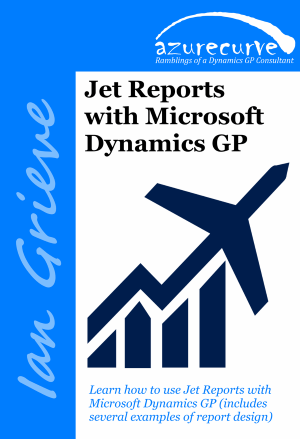 I spent 19 years working with Dynamics GP before I made the decision to switch to working with Business Central. My main reason for moving away from Dynamics GP is the same as many of the clients and prospects I have spoken to over the last few years; it was the expected future of Dynamics GP, or actually now the confirmed lack thereof, with the end of life announced in September last year.
I spent 19 years working with Dynamics GP before I made the decision to switch to working with Business Central. My main reason for moving away from Dynamics GP is the same as many of the clients and prospects I have spoken to over the last few years; it was the expected future of Dynamics GP, or actually now the confirmed lack thereof, with the end of life announced in September last year.
Even with the only announcement of the end of licence sales to new customers starting with perpetual licences in 2025 and then subscription licences in 2026, conversation around projects to replace it with a new system were starting to intensify, something which only increased pace with the end of life announcement.
While the end of life is a few years in the future, and if you have perpetual licences, you will be able to continue using Dynamics GP after this date, my best advice is to start looking at a replacement system now, while you can do so with some leisure, giving time for full consideration of options.
There are many alternative ERP systems in the marketplace, aimed at a variety of sectors and business sizes and it is difficult to say that one solution fits all. Some of the smaller clients with only a handful of users are considering Xero, while larger organisations are looking at systems like NetSuite and, especially, Business Central.
It is the last of these, Business Central which I selected as the product to switch to when I moved away from working with Dynamics GP. I did look at a few of the alternatives, both in terms of the software, but also the companies who implemented and provided consultancy services, and ultimately decided that remaining within the Microsoft ecosystem was the natural choice for me with my experience and skill set.
Staying within the Microsoft ecosystem gave me a choice; Business Central or Finance & Operations (or whatever Microsoft are now calling it). I ultimately decided on Business Central as it serves a similar market as Dynamics GP, both in terms of the type, but also the size of organisations.
It is an ERP system which scales very well from a handful of users up to several hundred; Microsoft typically target it at organisations with a turnover of up to £500m, showing how scalable it is considered. Licencing is based on the number of users, which means it scales quite well price-wise as well as in terms of functionality.
It has almost all of the same modules as Dynamics GP, US and Canadian payroll excepted, but these aren’t modules which are a concern for the clients with whom I work as they are typically UK and/or Ireland based.
So for a company using Dynamics GP, what makes Business Central the best replacement for Dynamics GP?
First, it is a Microsoft product and part of an ecosystem which is very familiar to users of Dynamics GP. There is full integration with Microsoft products such as Office, Azure and the Power Platform. Business Central’s integration with these products is much tighter than that of Dynamics GP, which would require additional products like OData Service or custom development to be done to integrate with some of these other Microsoft products; Business Central has this integration as standard.
Second, starting from Dynamics GP 10, both Dynamics GP and Dynamics NAV started to look more and more alike, with changes to the UI in both systems bringing them together. Business Central is a descendant of NAV and still shares a very similar look and feel to Dynamics GP, and especially of the Dynamics GP web client. This means that users are able to adapt quite quickly to Business Central, in a way that they potentially won’t with other non-Microsoft systems.
Third, in addition to the training provided by Business Central partners, like MADIC dynamics where I work, there is also a lot of material available directly from the Microsoft Learn platform and bloggers like myself.
My articles on Business Central are largely contained within these series:
- In Microsoft Dynamics 365 Business Central (Administration), how do I…
- In Microsoft Dynamics 365 Business Central (Customisation), how do I…
- In Microsoft Dynamics 365 Business Central (Financial), how do I…
- In Microsoft Dynamics 365 Business Central (Inventory and Warehouse Management), how do I…
- In Microsoft Dynamics 365 Business Central (Purchasing), how do I…
- In Microsoft Dynamics 365 Business Central (Sales), how do I…
- In Microsoft Dynamics 365 Business Central (Development), how do I…
- In Microsoft Dynamics 365 Business Central (Power Automate), how do I…
Fourth, Business Central is provided by Microsoft using the Software-as-a-Service (SaaS) model which means it is both scalable and stable, with Microsoft guaranteeing a 99.9% uptime. The platform is designed to be scalable so that a busy system is allocated more resources, so that performance doesn’t decrease in the way that an on-premises system will when it gets overloaded with users. Stefano Demiliani, a Microsoft MVP, did a good article late 2023 on how Business Central scales when there is a lot of processing happening.
As a SaaS system, it is also available to users via the web browser, or app, on any device size wherever the user happens to be; all they need is an Internet connection and they can access Business Central.
Fifth, Business Central has, through it’s integration with Power Automate, much better workflows available to it that Dynamics GP. These workflows are not just limited to workflow approvals, but allow all different automated processes to be created, including data extracts and updates as well as approvals. There are hundreds of actions available which allow you to interact with Business Central, as well as Microsoft favourites like One Drive for Business and SharePoint, but also many third party web services, including DocuSign.
Sixth, Business Central is automatically updated with new releases as they become available. You can delay the upgrade of a live system for a period of time while you do testing on a sandbox environment with a copy of the production system. These upgrades are included within the licencing for Business Central so there is no cost for the upgrade and little, if any, consultant or support time is required for a standard system. This substantially reduces the cost of ownership of the product as you don’t need to pay a consultant to upgrade your system.
Seventh, Business Central is being heavily invested in by Microsoft, with dozens upon dozens of enhancements being released twice a year in the release waves, available in April and October. This includes both new and improved functionality and also rapid deployment of AI Copilot technologies into Business Central for improved performance.
As I said near the start of the article, I did look at alternatives to Dynamics GP by looking into some of the other ERP available before I made my decision to switch to Business Central; I opted for Business Central as it seemed to be the best of the alternatives for the types of clients with whom I am used to working for the reasons outlined above.






